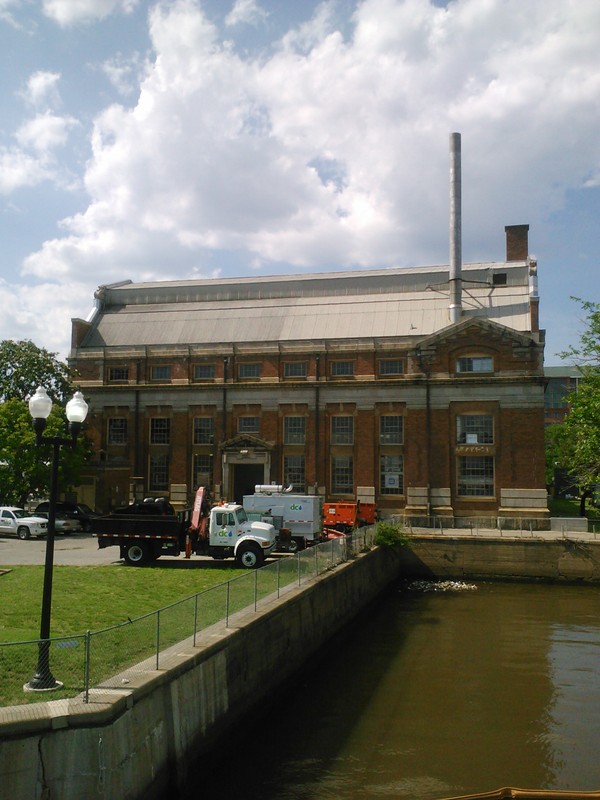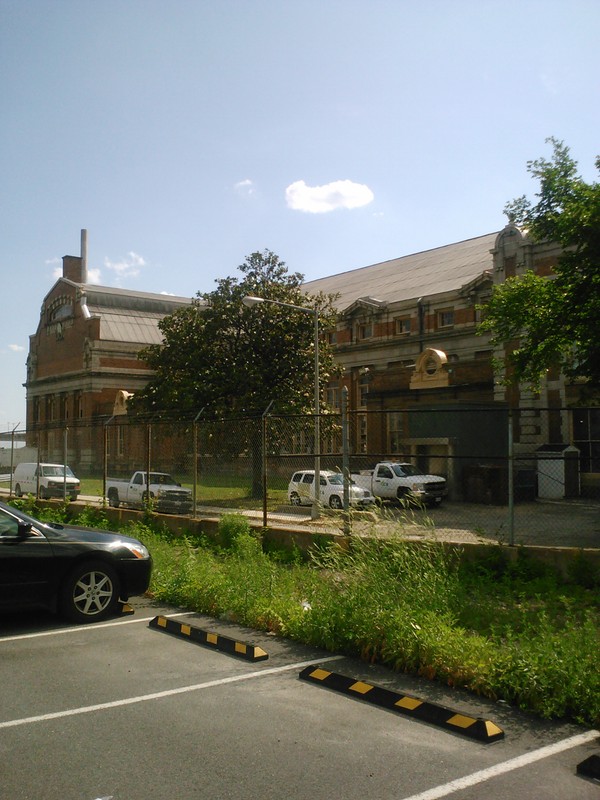Main Sewerage Pumping Station
Introduction
Text-to-speech Audio
Images
South side of the Main Sewerage Pumping Station. Image by Kumioko at English Wikipedia, CC BY-SA 3.0, https://commons.wikimedia.org/w/index.php?curid=52544808

East side of the pumping station. Image by Kumioko at English Wikipedia, CC BY-SA 3.0, https://commons.wikimedia.org/w/index.php?curid=36626709

Backstory and Context
Text-to-speech Audio
The Board of Public works built approximately 80 miles of sewers between 1871 and 1874. This system proved inadequate, owing to poor planning, faulty construction, and insufficient hydraulics. The condition of the Washington Canal and B-Street (today's Constitution Avenue) was particularly foul, leading to the construction of the B Street and Tiber Creek Sewers. In 1971, the Washington Canal, essentially an open sewer, was shut down and filled in. These solutions, however, only transferred the problem to the marshes along the Potomac and Anacostia Rivers.
In the 1890s, debates over the overall structure of the D.C. sewerage system prompted President Benjamin Harrison to appoint a Board of Engineers to decide on the matter. The implementation of the Board's recommendation to continue using a "combined system," wherein both sanitary sewage and stormwater was carried and discharged into local waterways, is still retained in the design of the current system.
Today, the D.C. sewerage system consists of approximately 1,800 miles of sanitary, combined, and storm sewers. Storm stations collect rainwater and direct it into the nearest river or stream. Wastewater also flows through the system, propelled primarily through the forces of gravity. Topological variation, however, necessitates the use of electric pumps to move the water through certain locations in the city. There are eight sewer pumping stations in D.C.
The Main Sewerage Pumping Station was built in 1907. Designed by architectural firm of C.A. Didden and Son, with the association of architect Oscar Vogt, this structure is considered the "most consequential building designed and constructed during the careers of all three architects."1 Architecturally, it is an example of the Beaux Arts public works buildings in the District. The 2-1/2-story brick building also incorporates features from the Renaissance-revival style. This structure reflects the design philosophies popularized by the City Beautiful Movement architectural and urban planning reform movement of the early 20th century. Its design was highly praised at the time, with the station being described at the "heart" of the sewer system.1
The Potomac, O Street, and Main Pumping Stations are manned continuously by personnel from the Sewer Services Department, with the D.C. Water Maintenance Branch conducting any necessary repairs. The main station is located in the Southeast Quadrant of the city on the Anacostia River, between the Washington Navy Yard and Nationals Park. On May 24, 2012, the National Park Service listed the Main Sewerage Pumping Station on the National Register of Historic Places.
Sources
1. Willams, Kim. "National Register of Historic Places Registration Form: Main Sewage Pumping Station." National Park Service, April 2012. Accessed November 4, 2016. http://historicsites.dcpreservation.org/items/show/716.
"Washington Canal Filled in." Histories of the National Mall. Accessed November 4, 2016. http://mallhistory.org/items/show/201.
"History of Sewer System." DC Water - District of Columbia Water and Sewer Authority. Accessed November 4, 2016. https://www.dcwater.com/wastewater_collection/history.cfm."Main Sewerage Pumping Station." Wikipedia, the Free Encyclopedia. Accessed November 4, 2016. https://en.wikipedia.org/wiki/Main_Sewerage_Pumping_Station.
"Sanitary Sewer System." DC Water - District of Columbia Water and Sewer Authority. Accessed November 4, 2016. https://www.dcwater.com/wastewater_collection/sanitary_sewer.cfm.
"Wastewater Collection/Sewer Services." DC Water - District of Columbia Water and Sewer Authority. Accessed November 4, 2016. https://www.dcwater.com/wastewater_collection/.
